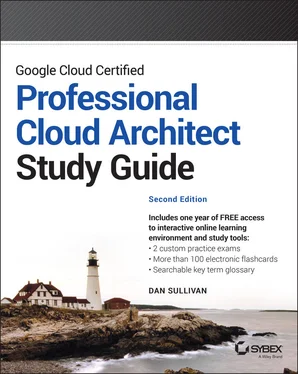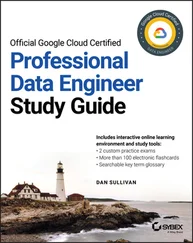When it comes to the Professional Cloud Architect exam, business requirements are pieces of information that will help you determine the most appropriate answer to some of the questions. It is important to remember that questions on the exam may have more than one answer that appears correct, but only one answer is the best solution to the problem posed. For example, a question may be asked about a small business application that needs to store data in a relational database, and the database will be accessed by only a few users in a single office. You could use the globally scalable relational database Cloud Spanner to solve this problem, but Cloud SQL would be a better fit to the requirements and cost less. If you come across a question that seems to have more than one answer, consider all the technical and business requirements. You may find that more than one option meets the technical or the business requirements, but only one option meets both.
This chapter reviews several key areas where business requirements are important to understand, including the following:
Business use cases and product strategy
Application design and cost considerations
Systems integration and data management
Compliance and regulations
Security
Success measures
Throughout the chapter, I will reference the case studies used in the Google Professional Cloud Architect exam.
Business Use Cases and Product Strategy
Business requirements may be high-level, broad objectives, or they may be tightly focused specifications of some aspect of a service. High-level objectives are tied to strategy, or plan, to meet some vision and objective. These statements give us clues as to what the cloud solution will look like. In fact, we can often estimate technical requirements just from statements about business strategy and product offerings.
Let's look at the three case studies and see what kinds of information can be derived to help formulate a solution.
The EHR Healthcare case study explicitly lists several business requirements, and from these statements, we can derive several facts about any solution.
The company provides business-to-business services to insurance providers. The time it takes insurance providers to start using the system, known as onboarding, needs to be minimized.
There is a mix of users, including medical offices, hospitals, and insurance providers. It is likely they all have different needs. For example, small medical offices may need more technical assistance when onboarding, while large insurance providers will likely have specialized data integration requirements.
Medical records management services cannot have extended periods of downtime. These systems need to be available 99.9 percent of the time.
Application performance is an issue. Latency needs to be reduced.
Since the applications store and process protected health information such as medical history, maintaining data confidentiality is a top concern.
The company is growing rapidly, and system administration costs cannot grow just because more infrastructure is added. System management practices should be designed to allow the organization to add infrastructure without needing to add staff to support it.
The company wants to use its data to derive insights about industry trends.
This list of business requirements helps us start to understand or at least estimate some likely aspects of the technical requirements. Here are some examples of technical implications that should be considered based on the facts listed previously:
Since the company is providing services to other businesses, customers will likely use public APIs.
There are many legacy systems in the insurance industry, so there may be batch processing jobs as well.
The need for availability calls for redundancy in infrastructure including compute, storage, and networking along with an architecture that prevents any single failure from making services unavailable.
With a goal of deriving insights from data, the company will likely keep large amounts of data for extended periods of time. This coupled with the sensitivity of the data will require careful planning of access controls and data lifecycle management policies.
Since the company serves customers in multiple nations and low latency is a goal, services and data will be served from multiple regions. For example, the EU's GDPR restricts the movement of records across national boundaries, which may have implications for region selection, storage strategy, and network topology.
The adoption of managed services will likely lead to a decrease in infrastructure administration costs. AI and machine learning managed services will allow the company to start deriving insights from data faster than if they built ML models from scratch.
These are just possible requirements, but it helps to keep them in mind when analyzing a use case. This example shows how many possible requirements can be inferred from just a few statements about the business and product strategy. It also shows that architects need to draw on their knowledge of systems design to anticipate requirements that are not explicitly stated, such as the need to keep application response times low, which in turn may require replication of data across multiple regions.
The Helicopter Racing League has several explicitly stated business requirements that fall into four categories: predictive analytics, increase viewership, operations, and increasing revenue.
The company wants to improve predictions during races, but they also want to expose their predictive models to business partners. Part of the business plan is to increase the type and amount of telemetry data collected.
Executives want to increase the number of concurrent viewers and reduce latency. This requirement will have a direct impact on technical requirements, especially related to scalability and geographic distribution of content and services.
Another business requirement is to minimize operational complexity and ensure compliance with regulations. This is a common requirement across the case studies.
The requirements specifically call for creating a merchandising revenue stream. It is not specifically detailed, but this may include branded merchandise such as clothing. This is a vague requirement and would require additional work to identify more specific details of the requirement.
Mountkirk Games is a company that makes online, session-based, multiplayer games for mobile platforms. The company is already using cloud computing. In the Mountkirk Games case study, we see an example of a product strategy that is focused on building on their cloud and application development experience to create a new product and improve the way they deliver services.
The business requirements include customer-facing requirements, such as supporting multiple gaming platforms and supporting multiple regions, which will improve latency and disaster recovery capabilities.
There is also a call for using managed services and pooled resources as well as support for dynamic scaling. We can see, given their use of Kubernetes, there will likely be an opportunity to use Google Kubernetes Engine as well as other managed services.
Here again, we see that business requirements can help us frame and anticipate some likely technical requirements. There is not enough information in the business requirements to make definitive decisions about technical solutions, but they do allow us to start formulating possible solutions.
The TerramEarth business requirements include improving the ability to predict malfunctions in equipment, increasing the speed and reliability of development workflows, and enabling developers to create custom APIs more efficiently.
Читать дальше












